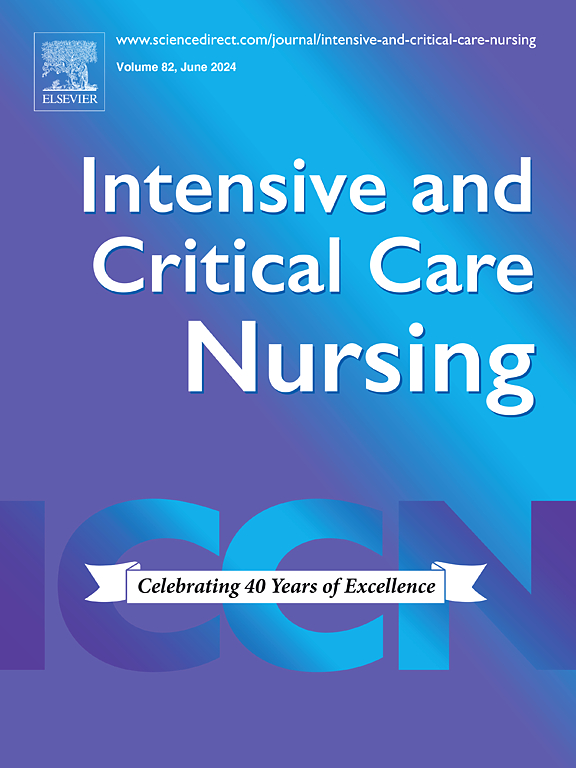Exploring differences in reported mental health outcomes and quality of life between physically restrained and non-physically restrained ICU patients; a prospective cohort study
IF 4.9
2区 医学
Q1 NURSING
引用次数: 0
Abstract
Background
Physical restraints are frequently used in ICU patients, while their effects are unclear.
Objective
To explore differences in patient reported mental health outcomes and quality of life between physical restrained and non-physical restrained ICU patients at 3- and 12-months post ICU admission, compared to pre-ICU health status.
Research Methodology/Design
Prospective cohort study. Patients were included when 16 years or older, admitted for at least 12 h and provided informed consent. Differences between groups were analysed using linear mixed model analyses.
Setting
Two ICUs, a 35 bed academic ICU and a 12 bed ICU in a teaching hospital in the Netherlands.
Main Outcome Measures
Symptoms of anxiety and depression were measured using the Hospital Anxiety and Depression Scale, post-traumatic stress disorder using the Impact of Event Scale-Revised, and Quality of life using the Short Form-36 scores.
Results
2,764 patients were included, of which 486 (17.6 %) were physically restrained for median 2 [IQR 1–6] days. Significantly worse outcomes were reported at 3-months by physically restrained patients (symptoms of depression 0.89, 95 %CI 0.37 to 1.41, p < 0.001; PCS −2.82, 95 %CI −4.47 to −1,17p < 0.001; MCS −2.67, 95 %CI −4.39 to −0.96, p < 0.01). At 12-months, only the PCS scores remained significantly lower (−1.71, 95 %CI −3.42 to −0.004, p < 0.05).
Conclusion
Use of physical restraints is associated with worse self-reported symptoms of depression and decreased quality of life 3-months post ICU, and lower physical quality of life after 12-months.
Implications for Clinical Practice
Use of physical restraints is associated with statistical significant worse mental and physical outcomes.
前瞻性队列研究:探究重症监护病房中被身体束缚和未被身体束缚的患者在精神健康结果和生活质量方面的差异。
背景:ICU患者经常使用物理约束,但其效果尚不清楚。目的:探讨身体约束与非身体约束ICU患者入院后3个月和12个月的心理健康结局和生活质量与ICU前健康状况的差异。研究方法/设计:前瞻性队列研究。纳入的患者年龄在16岁或以上,入院至少12小时并提供知情同意。采用线性混合模型分析各组间差异。环境:两个ICU,一个35床位的学术ICU和一个12床位的ICU在荷兰的一家教学医院。主要结果测量:焦虑和抑郁症状使用医院焦虑和抑郁量表测量,创伤后应激障碍使用事件影响量表-修订,生活质量使用短表36评分。结果:纳入2764例患者,其中486例(17.6%)患者受到身体限制,中位时间为2 [IQR 1-6]天。身体约束的患者在3个月时报告的结果明显较差(抑郁症状0.89,95% CI 0.37至1.41,p)。结论:使用身体约束与自我报告的抑郁症状加重和ICU后3个月生活质量下降有关,12个月后身体生活质量下降。对临床实践的启示:使用身体约束与统计上显着的更差的精神和身体结果相关。
本文章由计算机程序翻译,如有差异,请以英文原文为准。
求助全文
约1分钟内获得全文
求助全文
来源期刊

Intensive and Critical Care Nursing
NURSING-
CiteScore
6.30
自引率
15.10%
发文量
144
审稿时长
57 days
期刊介绍:
The aims of Intensive and Critical Care Nursing are to promote excellence of care of critically ill patients by specialist nurses and their professional colleagues; to provide an international and interdisciplinary forum for the publication, dissemination and exchange of research findings, experience and ideas; to develop and enhance the knowledge, skills, attitudes and creative thinking essential to good critical care nursing practice. The journal publishes reviews, updates and feature articles in addition to original papers and significant preliminary communications. Articles may deal with any part of practice including relevant clinical, research, educational, psychological and technological aspects.
 求助内容:
求助内容: 应助结果提醒方式:
应助结果提醒方式:


